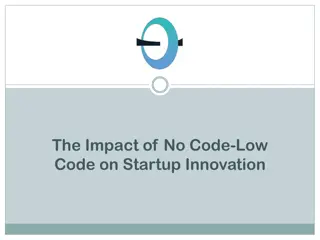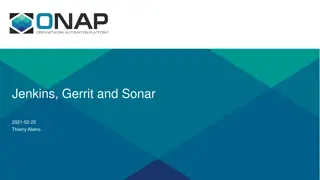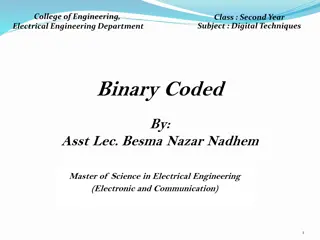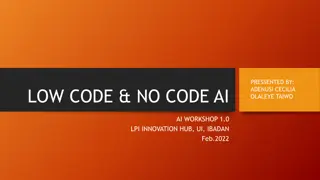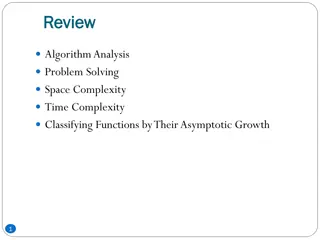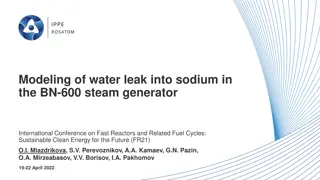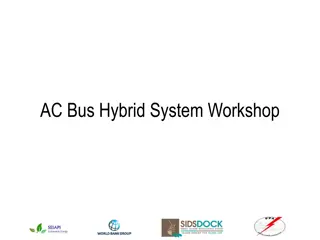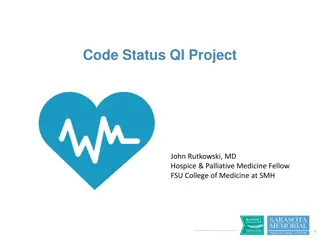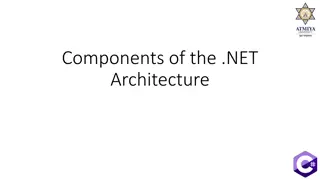Understanding LLILC: A Code Generator for CoreCLR with a Focus on GC
LLILC, utilizing LLVM as a code generator for CoreCLR, emphasizes Garbage Collection (GC) and offers insights on JIT compilation and pluggable Jit architecture. This open-source project provides a cross-platform capable version of the CLR and supports Portable API surface for .Net frameworks, enabling experimentation with code generation via NGEN/Crossgen. LLILC, an LLVM IL Compiler, aims to build an alternate JIT and handle runtime features such as GC effectively, making it a crucial component of the CoreCLR ecosystem.
Download Presentation

Please find below an Image/Link to download the presentation.
The content on the website is provided AS IS for your information and personal use only. It may not be sold, licensed, or shared on other websites without obtaining consent from the author. Download presentation by click this link. If you encounter any issues during the download, it is possible that the publisher has removed the file from their server.
E N D
Presentation Transcript
LLILC: LLVM as a code generator for the CoreCLR With a particular emphasis on GC Andy Ayers Microsoft
The CoreCLR https://github.com/dotnet/coreclr Open-source, cross platform capable version of the CLR Supports the Portable API surface for .Net frameworks
Codegen in the CoreCLR All methods jit compiled by default (no interpreter) Single-tier RyuJit comes with CoreCLR Pluggable Jit architecture allows for experimentation (aka alt jit ) Install-time codegen possible via NGEN/Crossgen There s an interface between the JIT and the VM, but Jit must know intimate details of many runtime features In particular, GC and EH This talk will focus largely on the implications of the GC
LLVM Suspect you all know what this is... Capable, cross-platform compiler and tools framework Supports various Jitting approaches, eg MCJIT
Introducing LLILC LLVM IL Compiler: An open-source, cross-platform capable code generator for the CoreCLR based on LLVM https://github.com/dotnet/llilc Aka lilac Initial focus is on building an alternate JIT
LLILC Implementation Currently using MCJIT For Windows, we added some basic COFF support to RTDlyLd CoreCLR handles all external symbol resolution for the JIT At some point we ll have to introduce a new runtime target since we don t have a CRT to fall back on JIT is multithreaded, all threads are independent of one another Using sys::ThreadLocal<T> to have per-thread LLVM context, etc Modelling CLR types as llvm types, hitting various complications Unions, unsigned types, padding,
Sample MSIL -> LLVM IR Translation static bool IsNullOrEmpty(String value) { return (value == null || value.Length == 0); } define i8 @String.IsNullOrEmpty(%System.String addrspace(1)* %param0) { entry: %arg0 = alloca %System.String addrspace(1)* store %System.String addrspace(1)* %param0, %System.String addrspace(1)** %arg0 %0 = load %System.String addrspace(1)*, %System.String addrspace(1)** %arg0 %1 = icmp eq %System.String addrspace(1)* %0, null br i1 %1, label %10, label %2 ; <label>:2 ; preds = %entry %3 = load %System.String addrspace(1)*, %System.String addrspace(1)** %arg0 %NullCheck = icmp eq %System.String addrspace(1)* %3, null br i1 %NullCheck, label %ThrowNullRef, label %4 ; <label>:4 ; preds = %2 %5 = getelementptr inbounds %System.String, %System.String addrspace(1)* %3, i32 0, i32 1 %6 = load i32, i32 addrspace(1)* %5 %7 = icmp eq i32 %6, 0 %8 = sext i1 %7 to i32 %9 = trunc i32 %8 to i8 ret i8 %9 ; <label>:10 ; preds = %entry ret i8 1 ThrowNullRef: ; preds = %2 call void inttoptr (i64 NORMALIZED_ADDRESS to void ()*)() #0 unreachable }
CoreCLR GC CoreCLR's GC generational fully relocating precise stop-the-world supports weak, pinning and interior pointers (no exterior pointers) code may be required to be fully interruptible or may be partially interruptible CoreCLR GC also supports a conservative mode which greatly simplifies the obligations of a code generator.
Requirements for Code Generation Generational JIT must insert write barriers for most stores of GC references Fully relocating JIT must anticipate that GC references may change at GC safepoints Precise JIT must precisely report the set of stack locations and registers that contain GC references at each GC safepoint JIT must not have GC references in callee save registers across native (aka pinvoke) calls that are GC safepoints JIT must sometimes keep on-stack GC references live even if there are no explicit uses in the code JIT may have untracked references (live at every safepoint) that are reported just once per method Object, Interior, and pinned references JIT must describe which type of GC reference exists in each reported location JIT must ensure that each reported location contains a valid reference No exterior references JIT must ensure that at each safepoint, each reported reference falls within the object being referenced Stop-the-world JIT must ensure that a GC safepoint is reached by each thread with sufficient frequency
LLVM Support for GC GCRoot Essentially allow for untracked reporting. Some stack slots are considered to hold GC references and those values are reported live at each safepoint. Statepoints Allows for tracked reporting. Set of GC references to report is customized at each safepoint via SSA variables. This gives us most of what we ll need, and we re going to build upon it Currently using addrspace(1) to tag GC references Statepoint insertion: liveness determines what references are live to each call
Statepoint example .method public hidebysig static int32 IL_0000: ldsfld IL_0005: ldc.i4.2 IL_0006: callvirt IL_000b: ret } Main() cil managed { class Program.Num Program.Test::A instance int32 Program.Num::Add(int32) define i32 @Program.Test.Main() gc "CoreCLR" { entry: br label %0 ; <label>:0 call void inttoptr InitClass(Program.Test, 2) %1 = load %Program.Num addrspace(1)*, ... %NullCheck = icmp eq %Program.Num addrspace(1)* %1, null br i1 %NullCheck, label %ThrowNullRef, label %2 ; <label>:2 %3 = call i32 Add(Program.Num addrspace(1)* %1, i32 2) ret i32 %3 ThrowNullRef: call void ThrowNullRef() unreachable } ; preds = %entry ; preds = %0 ; preds = %0 Statepoint insertion computes live set of GC refs at each call. Rewrites the call to a statepoint intrinsic that calls the original method and takes the GC refs as extra args. Return value and updated GC refs produced as result.
Statepoint Example (cont) ; <label>:2 %safepoint_token2 = call i32 (i32 (%Program.Num addrspace(1)*, i32)*, i32, i32, ...)* @llvm.experimental.gc.statepoint.p0f_i32p1Program.Numi32f (i32 (%Program.Num addrspace(1)*, i32)* Add, i32 2, i32 0, %Program.Num addrspace(1)* %1, i32 2, i32 0, %Program.Num addrspace(1)* %1) %3 = call i32 @llvm.experimental.gc.result.i32(i32 %safepoint_token2) ret i32 %3 ; preds = %.split The first %1 is the call argument this pointer; the second is the GC reference live into the call. Then a rewriting pass makes the potential GC update of %1 explicit. Any downstream uses of %1 will now use %3 instead. ; <label>:2 %safepoint_token2 = call i32 (i32 (%Program.Num addrspace(1)*, i32)*, i32, i32, ...)* @llvm.experimental.gc.statepoint.p0f_i32p1Program.Numi32f (i32 (%Program.Num addrspace(1)*, i32)* Add, i32 2, i32 0, %Program.Num addrspace(1)* %1, i32 2, i32 0, %Program.Num addrspace(1)* %1) %3 = call coldcc %Program.Num addrspace(1)* @llvm.experimental.gc.relocate.p1Program.Num(i32 %safepoint_token2, i32 6, i32 6) %4 = call i32 @llvm.experimental.gc.result.i32(i32 %safepoint_token2) ret i32 %4 ; preds = %.split
Correctness Challenges (Overview) GC references from unenregisterable value types Reporting GC reference kinds (interior, pinned, this) Ensuring there are no exterior references Ensuring the live reference set stays accurate Honoring semantics of pinning Fully interruptible reporting Keeping certain special locals live and reported to GC Interaction of GC and EH (funclets, etc) Ensure all callee saves are spilled at Pinvoke points Ensure all spilled callee saves are restored Ensure all reported slots contain valid references Ensure GC safepoints are hit frequently enough (GC polls in loops)
Callee-Save Spills and Restores If a callee save is spilled to the stack across a safepoint, the callee save must be restored from the stack. Consider... spill RBX br i1 %p, label %1, label %2 spill RBX br i1 %p, label %1, label %2 ;<label>:1 ...modify RBX br label %3 ;<label>:1 ...modify RBX restore RBX ret Tail Duplicate ;<label>:2 call[safepoint] f() br label %3 ;<label>:2 call[safepoint] f() // GC might modify spilled RBX restore RBX // this restore is not redundant ret ;<label>:3 restore RBX ret
Pinning Pinning ( fixed in C#) is used to temporarily stop an object from being relocated by GC, typically so the object can be operated on by non- GC aware code. The result of a pin is a native pointer. Point pt = new Point(); fixed (int* p = &pt.x) { // pt will not be relocated while control is in this scope } Pinned pointers must be reported live and pinned for at least the duration of the pin. If a pinned pointer is copied, at least one of the references must be reported as pinned at each safepoint in the pinned range.
Pinning, cont Problem: uses of the pinned objects aren't data-dependent on them pinnedLocal.mp = ... otherLocal.up = convert pinnedLocal.mp ... uses of otherLocal.up ... pinnedLocal.mp = null The constraint is something like: given any use that is transitively data- dependent on otherLocal (with maybe a special case to break out if otherLocal gets converted back to a reported pointer), if that use gets moved passed a store to pinnedLocal then it can't further get moved past a safepoint
Performance Challenges (Overview) Use untracked reporting to help manage time/space overhead of GC reporting Enregistration of GC references across calls But not pinvoke calls Stack-pack (color) conflicting GC reference locals together so they can be efficiently zeroed when necessary Stack-pack non-conflicting GC references together Defer/shrink-wrap GC reference initialization/nulling Defer/shrink-wrap callee save spills Ensure nulling writes aren t optimized away as dead stores Model side-effecting calls that can t cause GCs Don t report null pointers as live Optimize write barriers Minimize impact of safepoint insertion on optimization
Safepoint Placement Want to place safepoints early to lock in semantics and minimize the likelihood that some optimization breaks GC reporting Want to place safepoints late to give maximum ability to optimize Want to place safepoints in-between when optimizations need to take safepoints into account. For now we re placing them early, once we are confident GC is correctly reported, we ll start looking at alternatives.
Optimizing Write Barriers Remove unnecessary write barriers - for instance, no barriers are necessary on newly created objects that haven't crossed a safepoint. Note this will entail code-motion restrictions; a store with an elided barrier cannot cross a safepoint. Write barrier calls may be inlined or tailored to mesh with the allocator's needs. The actual barrier typically has fairly low register cross section, so customizing its register usage during register allocation is appealing. If the barrier is inlined, special care must be taken to prevent subsequent code motion. Merge barriers - the underlying GC may track suspect regions of older generations at page or larger granularity, so stores to contiguous or locally dense regions may be handled with a single write barrier. This can be especially useful in copy loops. No safepoint can appear between the actual writes and the ultimate reporting barrier. Storing null to a location may not require a write barrier. Defer lowering of stores requiring write barriers into helper calls so that upstream optimizations can deal with them more or less as normal stores.
Observations on LLVM In general it s been great to work with No codegen bugs found so far. All bugs are our own doing. Insertion point management has probably been the biggest pain Things we ve missed from other compilers Ability to model semantically meaningful machine exceptions Memory SSA Explicit alias dependence in the IR Explicitly tracked pointer kinds (managed, interior, etc) Easy ability to defer lowering of runtime abstractions Write barriers, virtual calls, type tests, etc
Current Status LLILC is open for business, and we welcome collaborators https://github.com/dotnet/llilc Able to handle around 95% of all methods in simple tests. CoreCLR allows LLILC to bail out and let the real jit handle the method so we can do incremental bring-up. GC in conservative mode during bring-up, working on implementing precise reporting. Should have it in place relatively soon. EH not handled yet LLILC also building and working for Linux x64
Possible Future Topics How we re handling EH CLR semantics are that MSIL opcodes can cause exceptions. Many of these naturally map to machine instructions, eg ldlen. Right now we insert explicit checks & calls to throw helpers (see NullRef example earlier). What needs to be done to get truly performant managed code GC is an important part of the perf story, but not the only part Check optimization (null, bounds, checked math, etc) is vital, especially with precise EH reporting per .Net standard Lots of managed idioms to handle High-level type-based optimizations (CoreCLR is type safe) Lots of cleverness around generics What a true ahead-of-time (AOT) system might look like



